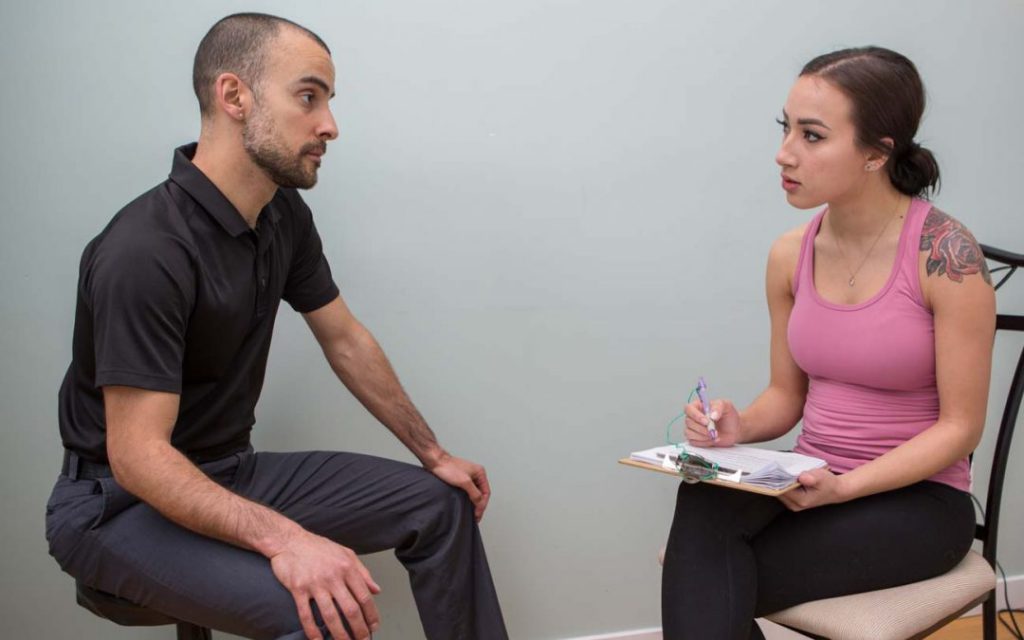“Listen to the patient”
In the lovely melodic tone of an unmistakably Trinidadian accent, these words still ring in my ears. “Taylah, Taylah, Taaaylah….you have to *listen* to the patient”. That’s what I heard at a disciplinary meeting before I was pretty sure I was going to get fired.
It was 2007.
I was a novice therapist who had already taken a lot of courses in osteopathic, and myofascial release techniques. It’s fair to say that I thought I was pretty darn good. I felt a deep responsibility to my profession, and to practice the way that I was taught in school. Perform a thorough assessment including all of the following, skipping no steps: a detailed case history, functional movement testing, active, passive, and resisted range of motion testing, length testing, manual muscle testing, joint play assessment, and orthopedic special testing. Believe it or not, I could pull that all off remarkably quickly, and most people didn’t complain, and even appreciated my thorough assessment style and attention to detail.
“I was a novice therapist who had already taken a lot of courses in osteopathic, and myofascial release techniques. It’s fair to say that I thought I was pretty darn good.“
2007 Me
One day I was working with a patient who was experiencing some back pain. With my then understanding of what was going on, I assessed that the problem was her L4 had a positional fault of FSRR (Flexion, Sidebent, and Rotated to the Right), in massage therapy school, I was taught to identify this as a capsular restriction of the anterior capsule on the left side. So, I began to perform the Muscle Energy Technique I had learned in my continuing education courses to correct it. As I began to get her into position, and she was following my cues perfectly (I was well practiced at directing patients confidently at this time already), she just shifted just a bit into extension (I think just to get comfortable, and with my thumb placed on the facet joint, there was an audible “click”. She heard and felt it too. She was instantly cured! She could once again move comfortably into spinal flexion and extension! She thanked me so much, and we continued the session with a nice and relaxing back massage.

A week later, she came back.
She was the last appointment of the day, and it was a last-minute booking. Without my knowledge, the receptionist took her right into the room. Reception told her to get on the table and that I would be right in. I was choked that reception did that, as my physical assessment begins as soon as I get eyes on the patient. I would much prefer to see them walk in, sit down (or not), take off their jacket, and observe for overt signs of pain behaviour (grimacing, bracing, sighing, limping, etc). That wasn’t available to me, but oh well…on with the appointment.
I get into the treatment room, and she was already lying face down.
I ask her a few questions and try to get a sense of what is going on. I gather that she is stressed about being late for her appointment and that she is certain that it is the “exact same thing as last time”, and she asked me to do “the exact same thing as last time”. I politely explain to her that in order for me do the same thing as last time, she would need to redress, so I could perform an assessment, identify the vertebral restriction, and then provide the specifically indicated treatment. She wasn’t sold on this idea. She became agitated, and told me that it was “the exact same thing as last time”, and because of that, I should be doing the exact same thing as last time. The more I tried to explain to her that in order for me to identify what the problem was, and perform the right treatment, I would need to perform an assessment, the angrier she became.
It became a stand-off.
She got to the point of demanding treatment without assessment. I crossed my arms and politely explained to her that she could go through a quick assessment and have this treatment, or she could choose to not have this treatment today. She literally threw a fit, pounding her fists and kicking her feet like a toddler who couldn’t have a juice box.
For those of you who don’t know me, my integrity will not be compromised. I also have a history of learning things “the hard way”. I’m far more mature, flexible and accommodating than this now, but I wanted to emphasize my stubborn, righteous, know-it-all new therapist mindset to give more context to the story.
There was no treatment that day. Needless to say…she complained to the management.
I was called into a meeting the very next day. Someone from the head office came down to talk to me. This gent is a prominent figure in our massage therapy community and someone for whom I have a lot of respect. That being said, I am intimidated by no one, and as far as I was concerned, I handled the situation correctly, professionally, and represented my profession with integrity.
I was wrong.
Though I think profanity is appropriate here, I’ll quote one of my favourite massage therapy instructors and just say “holy doodle”, I was wrong. Before I unpack what I learned from this experience, let’s continue to visit the disciplinary scene. Where was I? Oh yes…I was being, righteous, stubborn, and obstinate.
I was called into the boardroom for a meeting and was grilled by management and upper management for my mishandling of this situation. I don’t remember much, because honestly, I wasn’t really listening, but I do remember this: “Taylah, Taylah, Taaaylah…you have to *listen* to the patient”.

It took me another 7 years or so to understand the therapeutic value of listening.
I didn’t get fired, but I did move on to a place where I could practice in the way that I thought was best. I still wasn’t learning my lesson. It took another few years before I started to truly unravel how wrong I was, both in behaviour and “knowledge”. It took my beloved ortho model falling apart on me before I started to realize how wrong I had been, both information-wise, and how I was relating to my patients, but that is for another blog post.
Where I went wrong:
(Besides the fact that there’s no such thing as being able to detect and treat specific capsular restrictions, this isn’t that kind of post. If you take issue with that statement, PM me, and we have a long chat about that).
This woman was distressed because her back was hurting. She was also stressed from being late for a last-minute appointment. I never thought about this until just now, but maybe she booked a last-minute appointment because her back was hurting pretty badly, and she really needed some relief. Instead of compassion, she was received by an inflexible know-it-all who didn’t show her much patience, compassion, and wasn’t willing to accommodate her version of the treatment.
What I should have done:
There are probably countless ways that I could have handled that better. I could have just asked her how she wanted the massage to go. If I just gave her a really nice back massage (anyway she wanted it) and offered to perform the MET portion after, so that it worked better for time’s sake, that probably would have worked a lot better.
Maybe it’s because of hard lessons that I’ve learned like this, but now I consider listening to the patient to be one of the most important therapeutic tools I have in my tool-belt. It’s a practice…listening. It’s clearly a skill that can be learned, and improved upon.
Let me quickly share a bit about how I’ve seen it be an incredibly powerful therapeutic tool.
I can literally think of a dozen cases like this, but this is just the first one that comes to mind.
Let’s call her Sarah.
First appointment:
The patient presents with an antalgic gait, clear Trendelenburg, and steppage gait. She appears to be a patient with acute discogenic pain. Pain with coughing and sneezing, flexion intolerant, and hot lighting pain into the L5 dermatome distribution exacerbated with lumbar flexion or any bearing down. She also had an absent S1 reflex. On a side note, the S1 reflex returned when she was positioned into a bit of spinal extension on the table…neat hey?
Sarah had already completed 9 months of physiotherapy, and had returned to work, but was back off due to incapability to perform her job because of the pain and disability. The physio she was working with warned me that Sarah was a malingerer and that they already returned her to work successfully, so they were frustrated with her being back. I asked them how they could explain the Trendelenburg and steppage gait, and the absence of an S1 reflex if the patient was malingering. They just responded by saying “hmph…good point”.
Upon spending time listening to Sarah’s story, I found out that she had a bit of what I would call “good sport syndrome”. She continually performed exercises and stretches in her rehab/return to work program that was painful, but she went along with it because she trusted her professionals who “knew” what was best for her. She had a problematic understanding of pain physiology, and she thought her pain was all in her head, and that she was crazy. She felt hopeless, depressed, and she felt like a failure.
Sarah had severe pain with getting in and out of a chair, getting in and out of bed, and vacuuming. We did three or four sessions half and half movement modifications and gentle manual therapy. I showed her strategies for performing all of these tasks pain-free. After one session of movement modifications on her vacuuming strategy, she vacuumed her whole house that weekend, and felt great about it! After the second session, she established a pain-free hip hinge strategy to get in and out of chairs confidently without any pain. By the 3rdand 4thsessions, we were performing pain-free bird dog exercises. Pain-free and confident sagittal plane movements were almost fully returned in a couple of weeks. She was particularly happy that she could shave her legs again.
She thought she was crazy. This isn’t uncommon. It’s my experience that people who are in persistent pain, and who have experienced months of failed treatments really want to tell their story, and when I listen patiently (without thought to how much hands-on time I will be giving them), major missing pieces of their puzzle are revealed, so we can better design a road to recovery.
Humbly, a bit of advice that took me far too long to appreciate: don’t even hesitate to take the time to listen to your patients tell their stories. The missing pieces to their puzzle are probably not in our box of techniques but in their story.
Thanks for reading.
– TJ

